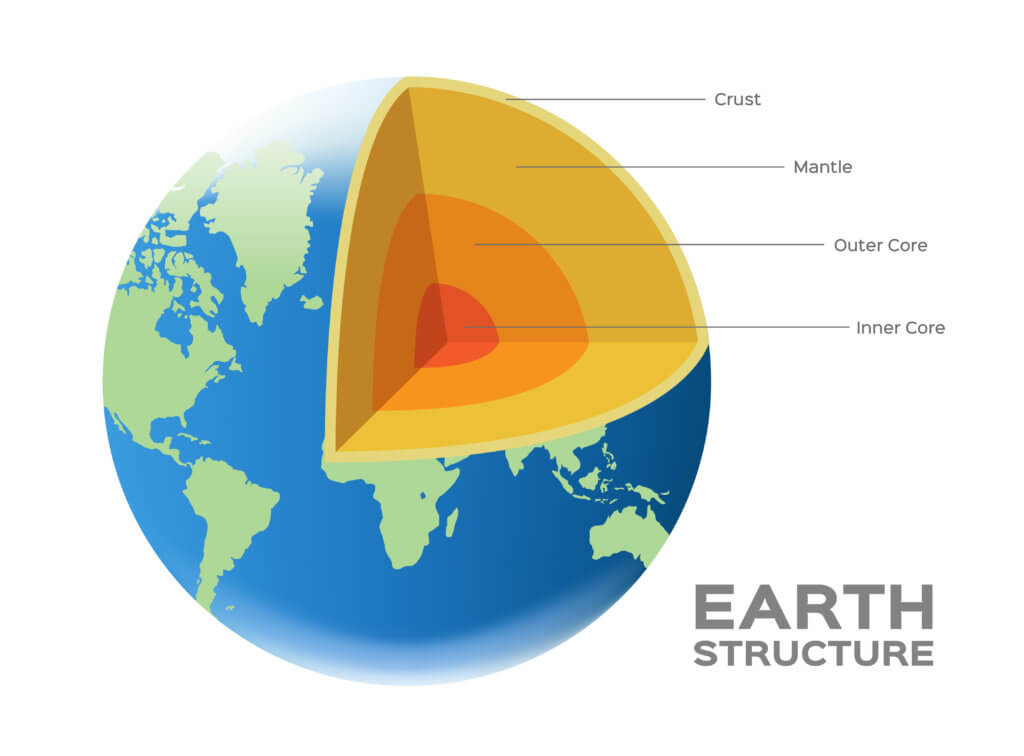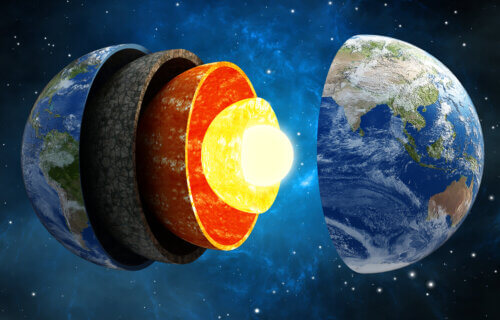SALT LAKE CITY — Scientists are trying to go where no man has gone before, into the inner core of Earth! A team of scientists at the University of Utah has made significant progress in understanding the formation and structure of the planet’s enigmatic inner core. They believe seismic waves from natural earthquakes will help unravel the secrets of this hidden area.
The inner core, a solid metal ball within our planet, not only influences its magnetic field but also plays a crucial role in supporting life on Earth. The study reveals that the inner core is far from being a uniform mass, contrary to previous assumptions. Instead, it is more akin to a tapestry, composed of various “fabrics.”
“For the first time we confirmed that this kind of inhomogeneity is everywhere inside the inner core,” explains lead author Guanning Pang in a university release.
By examining seismic data from a global network of detectors initially established to detect nuclear blasts, the researchers gained insights into Earth’s deepest reaches.

Keith Koper, a seismologist involved in the study, likens the exploration of the inner core to a frontier area. He emphasizes that imaging the interior of Earth’s core is challenging due to its depth and unknown characteristics. The seismic waves generated by earthquakes provided valuable information, as they propagate through the planet’s crust, mantle, and core.
“The planet formed from asteroids that were sort of accreting [in space]. They’re running into each other and you generate a lot of energy. So the whole planet, when it’s forming up, is melting,” Koper explains. “It’s simply that the iron is heavier and you get what we call core formation. The metals sink to the middle, and the liquid rock is outside, and then it essentially freezes over time. The reason all the metals are down there is because they’re heavier than the rocks.”
The team’s analysis of seismic data, collected from 2,455 earthquakes, unveiled the structure and behavior of Earth’s inner core. They discovered that the inner core’s inhomogeneity strengthens as one goes deeper toward the center of the Earth. This observation provides insights into the growth process of the inner core over time. The inner core grew rapidly in the past, reaching an equilibrium, and then continued to grow at a slower rate. This growth process resulted in the presence of trapped liquid iron within the solid core.
The significance of this research extends beyond expanding our understanding of Earth’s core. It demonstrates the power of utilizing seismic data to unlock hidden information about our planet. The findings contribute to ongoing efforts to predict seismic activity, improve weather forecasting, and advance our knowledge of Earth’s atmosphere. The research team’s work opens the door to further exploration of Earth’s deep interior, paving the way for future discoveries.
The study is published in the journal Nature.


The Earth does not have concentric layers as shown in this picture.
If we assume the cores sre made entirely of protons ,
The Sun and all the the planets are similar .
We have a Newton gravity balance that gives us 9.8 for earth 274 for our Sun …and other quantifiable figures for Mercury Venus Earth Mars Jupiter Saturn Uranus Neptune .
These extremely dense interiors have a magnetic field , that holds all the planets in
position.
At the centre is our Sun holding our Solar System in position.
Scientists don’t know exactly how fast the early Earth rotated, though they estimate it spun around completely in about 2 to 5 hours at the time of the magma ocean’s existence.
A fast rotating liquid sphere likely forces gas to the center and heavy mass to the surface..
Or, it could that author Barbara Marciniak was right, that the Earth’s Core came from debris from an exploded Star, >4.0+Billion years ago, and is actually made mostly of, wait for it, Metallic Hydrogen! Wow! That could explain a lot.
So heavy metal gatherings are the most important thing to our planets formation and all life on earth. Meanwhile everytime my wife hears “down with the sickness” on the radio she tries to divorce me. Somethings not adding up here
Ha that’s a good one..
Ooh ah ah ah ah! Lmao
😆
Yes everything has layers to keep it in Ballance even the sun has layers every planet has layers in it so ever runs together as one instead of separating and divide they can stay together as one which we all should do but there’s people that don’t like that but everything is good
You really need to think about this why are the scientists so hell bent on finding another planet. Honestly don’t people think and all the rich people could easily spend their money on the problems that are facing us right. I totally disagree with all the exploration of other planets to live on seeing that we have screwed up this planet and really do we want to screw up another planet think of a way to fix the problems here.
Earth is a Star on less mass. In that order liquefies during the burn, liquefied substance cools down shaping the crust both ways. Below the crust by the active radius and on face by the shaped volcanism. In our case 70 million years ago we had an act of Compression, on a thin crust back then, who send a big piece our crust in orbit. creating the today’s Moon. The time for another act of Compression (the last one) is up. This time the crust as a result of her heaviness will not go that far, will fall back destroying our Planet. I got a plan about it posted on my web site but, my portfolio is as thin as a hair.
Old news….
The Earth as are all planerts with a magnetosphere Hollow.
Admiral Byrd said he went beyond the pole and entered the egress at the polar region where Temps are warm.
The planet is alive.
If it were a solid rock as we are led to believe, we wouldn’t be here.
As above, so below.
This is one of the most coveted secrets known only to those who dare to defy founded scientific principals and find out for themselves and the surface countries that finance their explorations.
Yh My ancestors are from there my grandad just clawed he way out he couldn’t take the pressure
Theories are great and all, but at the end of the day they are just that…. “Estimated intellectual guesses” … My theory is that there’s more dirt down there…
or Sun within..
The title is a conceptual lie – “planet within a planet”. I hope the coining of the title does not ulterior intention.
What is the definition of the first ‘planet’ and then the second ‘planet’. If both the time the definition is the same, then why just ‘metal’ alone there in the second.
Planet or Hell 😅🙆♀️
Sometimes one has to wonder how these people are tolerated.
So when ‘asteroids’ fly around in space instead of bumping into each other and bouncing off, like billiard balls and the Kuiper Belt for the last 4 billion years, oh no, they all get together, put the metals in the middle and then form a single solid crust and cover it with water.
The disgusting part of this article, is not that some idiot gets to make up nonsensical fairy tales for which taxpayers reward him, but that the idiot gets to teach students this nonsense and fails them (punishes them) if they dispute it.
“If we assume the cores sre made entirely of protons”, exactly why would anyone assume that ???
Only Hydrogen has a ‘core’ made entirely of ‘proton’ (singular) and is has a shell with an electron.
Please explain where and when any known element (except Hydrogen) has a core made of protons.
Assuming one could (somehow) create such a mass (entirely of protons) how stable would it be and given that it was positively charged how would it react to the rest of the universe?
We live on the outsides of planet and lots of gray or white ring , insect’s animals never seen by humans in the insides.
Lots of individuals in n the outside while theirs different kind of world inside, like the trees that we see standing so beautifully with or without leave. May dead and dry but it’s home for many.